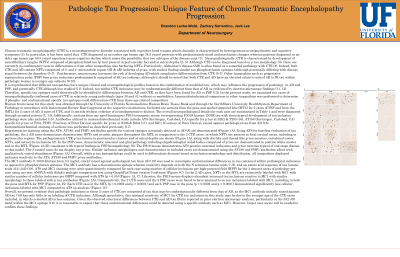Pathologic Tau Propagation: Unique Feature of Chronic Traumatic Encephalopathy Progression
Friday, April 21, 2023


Brandon P. Lucke-Wold, MD, PhD
Resident
University of Florida
Gainesville, Florida, United States
ePoster Presenter(s)
Introduction: Chronic traumatic encephalopathy (CTE) is a neurodegenerative disorder characterized neuropathologically by aggregates of intra-neuronal phosphorylated tau (p-tau), similar to Alzheimer’s disease (AD) and other tauopathies but with distinguishing features such as a predilection for pathology at perivascular foci and sulcal depths. Neuropathologically differentiating CTE and AD can be challenging, particularly in elderly patients with abundant amyloid plaques, as there are no p-tau antibodies that selectively distinguish between the neurofibrillary tangles (NFTs) in CTE and AD. P-tau is purported to be biochemically distinct between various tauopathies which may reflect the unique characteristics of each disease, and various assays have demonstrated these structural differences in tau amongst tauopathies including between CTE and AD.
Methods: Herein, we utilize a battery of phosphorylation and conformation specific tau antibodies on two cases of neuropathologically confirmed young onset CTE (ages 30 and 41 at death) and compare to known staining profiles in samples from other tauopathies including AD, progressive supranuclear palsy (PSP), and a mouse model of tauopathy (PS19 transgenic line).
Results: We demonstrate that the MC1 antibody minimally detects p-tau in CTE and PSP cases while abundantly labeling inclusions in AD. The unique tau feature of CTE shows early propagation.
Conclusion : The MC1 antibody or target epitope may be useful in pathologically differentiating AD and CTE for early diagnosis.
Methods: Herein, we utilize a battery of phosphorylation and conformation specific tau antibodies on two cases of neuropathologically confirmed young onset CTE (ages 30 and 41 at death) and compare to known staining profiles in samples from other tauopathies including AD, progressive supranuclear palsy (PSP), and a mouse model of tauopathy (PS19 transgenic line).
Results: We demonstrate that the MC1 antibody minimally detects p-tau in CTE and PSP cases while abundantly labeling inclusions in AD. The unique tau feature of CTE shows early propagation.
Conclusion : The MC1 antibody or target epitope may be useful in pathologically differentiating AD and CTE for early diagnosis.
